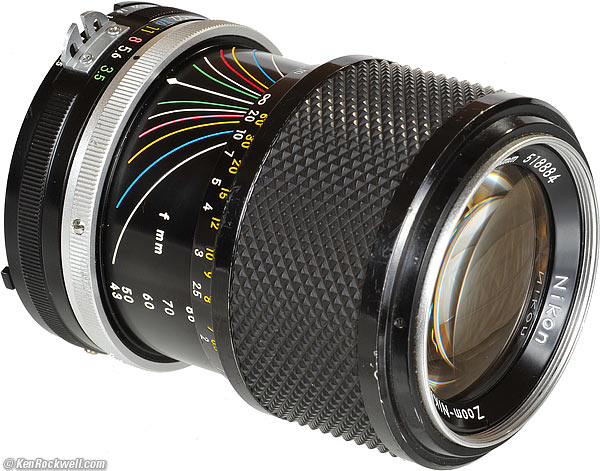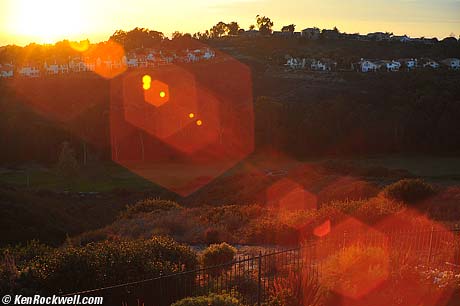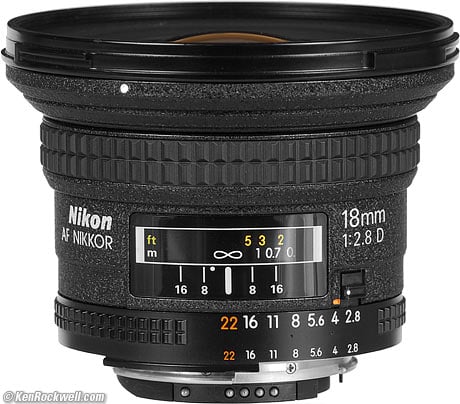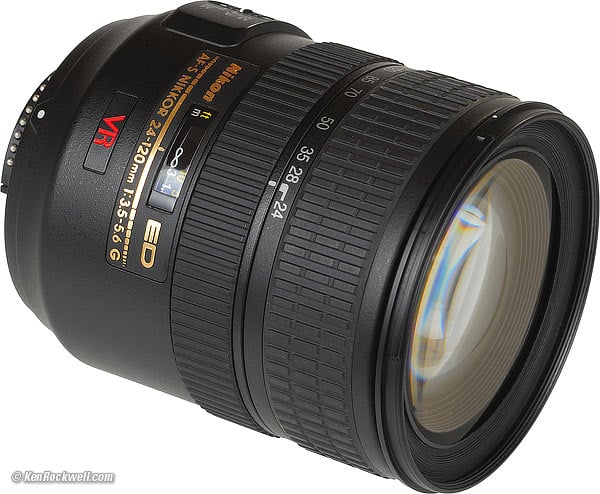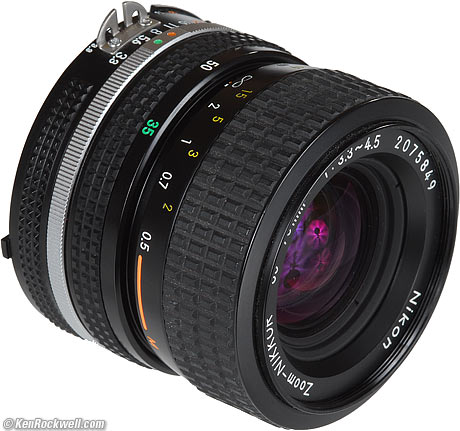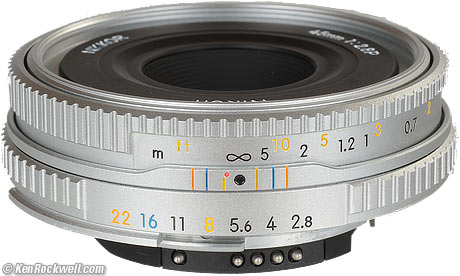Home New Search Gallery How-To Books Links Workshops About Contact
Nikon's 10 Worst
Lenses I get my goodies at Ritz, Amazon and Adorama. It helps me keep adding to this site when you get yours from those links, too. July 2008 More Nikon Reviews Nikon's 10 Best Lenses For a lens to be awful it has to be a failed dream. Crappy optics alone won't get it here. For instance, the first 50-300mm f/4.5 lens of 1968 was among Nikon's least sharp lenses ever, but we expected that from the zoom which also was the world's widest-zoom range lens ever made for 35mm SLR cameras. (The recent 50-300mm f/4.5 ED is a different and excellent lens.) An expensive, exotic lens is even more of a dud when its optics don't measure up to older and less expensive lenses. These are in no particular order. All these cover FX, DX and film. Click the lens pictures (or links) to get to their individual reviews. Don't forget to read Nikon's 10 Best Lenses.
Nikon's 10 Worst Lenses top Even lenses that aren't very sharp can be used to make incredibly great photos. However, as lenses go, these are the pigs at Nikon's party. Given any of these lenses I could go make images as good as any of my others. As lenses go, each of these isn't just me saying they are duds; for each one, plenty of others have confirmed my observations. These are all this bad.
43-86mm F (1963-1976)
Nikon 43-86mm f/3.5 F. The original Nikon 43-86mm is the worst lens Nikon has ever made. It's worse than the worst, because not only is it terrible by itself, it was so awful that it has tainted the reputation of all other zoom lenses to this day. What makes it so bad? It's Nikon's softest lens, and is loaded with untold levels of distortion. It also has awful flare and ghosts.
How bad it was! Ghosts everywhere!!! (D3, 43-86mm f/3.5 F at f/8) When people say zooms aren't sharp, zooms flare, and zooms have a lot of distortion, it is because this horrible lens set these expectations. The 43-86mm came in two versions. This first horrible version has the lettering inside the filter ring. The later version (1975-1982) is a completely different lens, and is just fine. It has its lettering outside the filter ring.
18mm f/2.8 D AF (1994-2006) top This is Nikon's worst 18mm lens ever. The embarrassing part is that it cost $1,300 new (at full NYC discount), and still sells for about $800 used, and it's much worse than Nikon's older 18mm lenses. It uses every trick Nikon knows, and is worse than earlier lenses! The 18mm f/2.8 D AF uses internal focusing and aspheric elements, and somehow winds up being softer and having more distortion than Nikon's original 18mm f/4, 18mm f/3.5 AI-s, or their current zooms. It has a lot of falloff wide-open, too. As we politely refer to a morbidly fat person as "having a slight weight problem," this 18mm lens has a slight ghosting problem. It has more ghosts than any other 18mm lens, and probably more ghosts than any other Nikon lens except the original 43-86mm above. I have no idea why it's so bad, but it is. This 18mm AF is one of the very few lenses for which I would use a hood. Good luck if you get stuck buying a used one without its original HB-8 hood; these hoods are now impossible to buy new or used. The 18mm f/2.8 is a decent enough lens by itself. Since it's so expensive and even worse then the lenses it replaces, it earns itself the top position on my 10-worst list, just behind the hideous original 43-86mm.
300mm f/4.5 P (1964-1969) top The 300mm f/4.5 P was Nikon's first 300mm SLR lens. It only had 5 elements (that's the "P," as in "penta"), and was loaded with color fringes. Even on film, the results were always loaded with primary (red-blue) lateral color fringes on the sides of the picture. Stopping down made them worse, since as the lens sharpened up, the fringes became more visible. In 1969 Nikon replaced this 300mm f/4.5 P lens with the excellent 300mm f/4.5 H. The H means 6 elements, as in "hex." Nikon made the excellent H version in various cosmetic variations though 1998.
24-120mm VR (2003-today) top The 24-120mm VR is a failed dream because it's too darn soft. At 24mm, the corners on film and FX are soft. It's softer than any other Nikon lens I've tried at the wide end. It's on my 10-worst list because it's new enough and made with enough technology that it ought to be fine. It's not, and Nikon's MTF curves show you that Nikon designed it this way. This was the first lens I tried on my D3. Not only was it soft at the wide end, even stopped down, the corners got too darn dark from falloff at 120mm, where it's only f/5.6 wide-open.
35-70mm f/3.3-4.5 AI-s (1984-2005) top
Nikon 35-70mm f/3.3-4.5 AI-s. This is a cheap and crappy lens. Nikon has made other cheap lenses which make it to my 10-Best list that are great. This lens simply isn't very sharp, and is unbecoming to Nikon's manual focus Nikkor lenses with its use of plastic. The focus, zoom and aperture rings are plastic, and even the silver grab ring may be plastic. It looks like a tough metal Nikkor, but it's not. I don't mind plastic if it's sharp like the Series E lenses, but this isn't a sharp lens. Its loaded with distortion, too. The same optics appeared in an AF version in 1986. As an AF lens, the optics are sad, but the mechanics and usability are swell, so I wouldn't put it on my Worst list if it weren't for the dishonorable manual focus version above. Nikon 35-70mm f/3.3-4.5 AF. (1986-1994) enlarge. Nikon also sells, even today, a 35-70mm f/3.5-4.8 manual focus lens sold with the FM-10. It doesn't make it to this list because it isn't even a Nikon lens. It's really a Cosina lens made by Cosina and branded Nikon.
Nikon 45mm f/2.8 P (2001-2006) top The 45mm f/2.8 was introduced in 2001 as a vanity accessory along with the new Nikon FM3a manual-focus body. It was very expensive, $450, and was claimed to have magical powers which imbued it with extraordinary optical performance. We rational types read Nikon's PR which said that it was just a primitive Tessar design. The Tessar design, over 100 years old, was good in its day, but the Nikon 45mm P is far softer than the $120 made-in-China 50mm f/1.8 AF lens in my 10-Best list. Sure, this 45mm is small, but its performance is sucky (especially in the corners of FX) compared to every other current Nikon normal lens, and it costs far more. If you're just shooting DX, you aren't using the corners and it probably looks fine. The P in this lens stands for "Program," as this manual-focus lens has electronic contacts to let it talk to the metering systems of digital and autofocus film Nikons. All cameras treat this lens as if it's an AF lens, except that it can't autofocus. Needless to say, Nikon didn't fool anyone, and discontinued this lens with lots of stock on dealer's shelves in 2006. Its only purpose, other than as a tiny lens, is as a collectors item, since it was packaged as a couture item shipped with with color-coordinated caps, hood and a filter. And just like couture items, it's a pain to use. Its so tiny that there is no room for a grip ring for mounting and unmounting, so you have to run the focus or aperture to one end before you get any traction to the mount. People whined about the thin plastic focus rings of Nikon's first AF lenses, but the 45mm P is the worst. Its focus ring is a cold, hard, miniscule metal ring, Nikon's worst ever. Even the scalloped rings of Nikon's first SLR lenses were far better, as were the wider rings on Nikon's 1940's rangefinder lenses. It uses almost the same optics as Nikon's 45mm f/2.8 GN (1968-1977), which was Nikon's very least expensive lens in its day. I've compared them both on the D3, and they are both about the same. The older 45 GN additionally offered a superior 9-bladed (later 7-bladed) diaphragm, and a built-in analog computer that calculated flash exposure automatically as focused. This 45 P offers none of this. The 45 GN is a decent lens, but when you try to charge this much for the 45 P, it's on the bottom my suck list.
Where Are the Other Four Worst Lenses? top They're the ones you bought but never take out and use. Seriously, "10 Worst" makes a better title than 6 Worst, and gives Nikon room to screw up in the future without me needing to rename this article. I have my eyes on some lenses that I just might add here if they don't behave. The 28mm Series E comes to mind.
PLUG I support my growing family through this website. If you find this as helpful as a book you might have had to buy or a workshop you may have had to take, feel free to help me continue helping everyone. If you've gotten your gear through one of my links or helped otherwise, you're family. It's great people like you who allow me to keep adding to this site full-time. Thanks! If you haven't helped yet, please do, and consider helping me with a gift of $5.00. It also helps me keep adding to this site when you get your goodies through these links to Adorama, Amazon, B&H, Ritz, and J&R. I use them and recommend them all personally. Thanks for reading!
Ken |
Home New Search Gallery How-To Books Links Workshops About Contact

